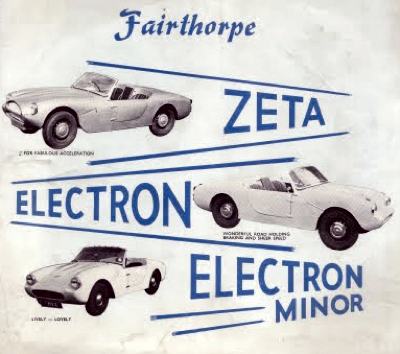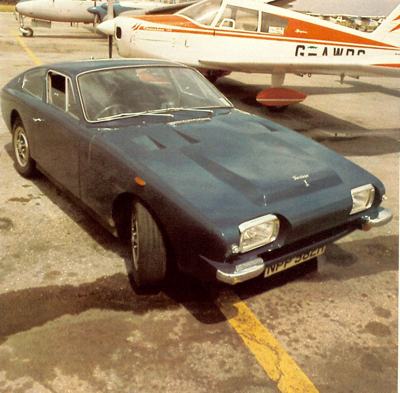In the late 1940’s and early 1950’s England was still feeling the after affects of World War 2 and, although promises had been made that the country would quickly recover from the post war austerity, food and petrol were still rationed and times were hard. England, therefore, hardly seemed the place where a new car craze would start, let alone catch on. However, start it did, and small car makers began to spring up all around the country, like London Pride growing from the debris of the blitz-torn capital.
It is hard to understand how they prospered - perhaps the ambitious types thought it would be a profitable field in which to start afresh - but probably it was because there was a great demand for the type of vehicle that the new generation of makers were producing: low-cost sports cars based on the mechanical parts of cheap saloon cars and, in some cases, even using motor-cycle engines.
The price asked for the cars on offer was so low that the cost of having a 'different' vehicle from everybody else was well within the reach of motoring enthusiasts. Everyone tried to jump on the bandwagon and the makers were many. Names like Ashley, Berkeley, Buckler, Falcon and Turner have long been erased from the memory.
It seemed, as the 1950s turned into the 1960s and, subsequently, the 1970s, that each day that brought the arrival of a new manufacturer saw at least two others fall by the wayside and, unmourned, quietly fade away. One such company born in that tradition was Fairthorpe Ltd, a firm, that managed to last for a quarter of a century, operating in Denham, Buckinghamshire, the factory being an aircraft hangar.
Air Vice-Marshal Donald Bennett CB CBE DSO
The company was founded by Air Vice-Marshal Donald Bennett CB CBE DSO, ex Air Officer Commanding the Pathfinder force of RAF Bomber Command from where he earned the name of 'Pathfinder' Bennett. The first car that was built at the company's Chalfont St Peter home was the Atom coupe, a glassfibre two to four-seater with Standard-Triumph running-gear and a choice of BSA 250, 350 or 650 cc motor-cycle engine mounted at the rear of the car. Although the Atom was rather basic and lacking in comfort, it proved to be fairly quick especially in 650 cc form and, of course, each version was very frugal with fuel which was the main intention of the designer.
To say that the car, with a roof that sloped at an angle of 45 degrees to its pointed tail was unconventional in appearance would be an understatement. However, the car was quite successful and enabled the company to get on its feet and into production with the Atomota. This was similar to the Atom but with its 650 cc engine front-mounted. In 1957, a more conventional new model, the Electron Minor, was announced; this was to be the mainstay of the company right into the 1970s. The EM utilised a Standard Eight engine and gearbox unit and, with 38 bhp on tap, the open-top two-seater had a top speed of 75 mph and lively, if not startling, acceleration.
 The Fairthorpe Zeta.
The Fairthorpe Zeta.
 1961 Fairthorpe Electrom Minor Mk III. The body and chassis was the basis form many other Fairthorpe models, ranging from the unsuccessful Electrina sedan to the powerful Ford Zephyr engined Zeta, which had a 130 mph top speed and could accelerate over a quarter mile in a little under 15 seconds.
1961 Fairthorpe Electrom Minor Mk III. The body and chassis was the basis form many other Fairthorpe models, ranging from the unsuccessful Electrina sedan to the powerful Ford Zephyr engined Zeta, which had a 130 mph top speed and could accelerate over a quarter mile in a little under 15 seconds.
 1971 Fairthorpe TXSS. It was powered by a TR6 engine producing 152 bhp and had brilliant acceleration.
1971 Fairthorpe TXSS. It was powered by a TR6 engine producing 152 bhp and had brilliant acceleration.
 1968 Fairthorpe TX GT. It used a larger body than the TXS and TXSS, and also featured an opening rear door.
1968 Fairthorpe TX GT. It used a larger body than the TXS and TXSS, and also featured an opening rear door.
 |
The Fairthorpe EM
Once again the styling of this Fairthorpe was unusual, but the car did fairly well in club-racing events of the late 1950s; its body was obviously more attractive to the
aerodynamicist than to the motor-racing spectator. A larger-engined derivative followed a year later. This was the Electron, which was powered by the popular 1098 cc Coventry Climax engine.
The 84 bhp produced by the engine, coupled to the light body, made the Electron one of the quicker cars in its class both on road and track. 1959 saw the company move slightly further up-market, with the Ford Zephyr-powered Zeta. However, the 130 mph plus performance that the highly-tuned engine gave, in the Electron-based chassis, was perhaps too much and the car was dropped after only 14 cars had been built, although its sister car powered by the 1596 cc Triumph Vittesse engine, the Rockette, handled somewhat better.
In 1964, the firm moved temporarily to Gerrards Cross while the EM grew even more popular, being fitted now with an 1147cc Triumph Spitfire engine. Donald Bennett's son, Torix, had by now started taking an active interest, and the company was renamed Fairthorpe Technical Exponents.
This coincided with yet another move, this time to Denham, alongside the aerodrome where Air Vice-Marshal Bennett worked with one of his two other firms; Dart Aircraft Ltd. With the move to Denham and the new name, the firm began to adopt a different image. It drifted away from the basic sports models to proper grand-touring cars, the first being the TXI designed by Torix, hence the TX designation.
The Fairthorpe TX1
The TX1 was the first Fairthorpe to feature the ingenious transverse-rod rear suspension. The system was of the trailing type hung on coil springs with adjustable concentric dampers. The upper links on each hub carrier crossed over and link to the lower part of the carrier on the other side. When the TX1 cornered at high speed, the wheels thus remained parallel and approximately vertical, despite body roll.
By 1968, the TXI had been given the Triumph GT6 2-litre engine, along with a new-style body. The TXGT, as it was named, was aimed at the potential GT6 buyer who wanted a compact, three-door sports car, but without the notorious swing-axle suspension system that was used on the early GT6s.
By this time, the EM was using the 1296 cc Triumph Spitfire engine which gave the car a top speed of 103 mph and an acceleration figure of 0-60 mph in 10 secs. Perhaps the first Fairthorpe that could be considered good-looking, by some at least, was the TXS series. This was introduced not long after the GT, being a lower, lighter version without the third door.
As with all the cars built since 1958, the TXSs were available in kit form which, until the introduction of VAT, meant a great saving for the buyer; sometimes as much as 25 per cent over the assembled car. Initially, the TXS and TXSS (a fuel-injected TXS), with their bodies made up from separate glassfibre panels for easy repair work, had the 1998 cc GT6 engine.
The injected version was tremendously quick due to its power/weight ratio of 200 bhp per ton. It had a top speed of 132 mph and could accelerate to 60 mph in 6.4 secs. Somewhat strangely, though, the transverse rod suspension was now offered as an extra, at a price of UK£45.
A conventional double wishbone layout was the standard fitment on the back of the greatly strengthened TR6 chassis. The Denham- modified TXSS engine gave way, in 1971, to the 2.5-litre unit in either 132 or 152 bhp form. In gaining the larger engine, the car acquired a large bulge in its bonnet, impairing looks somewhat.
With Torix starting his own TX firm, building the Trippers sports-car-cum-buggy, the Fairthorpe range in 1974 was pruned to contain the Electron Minor Mk VI, available with a supercharged engine, the TXS, which was reduced to Spitfire power - although also available with a supercharger - and the top of the range TXSS.
Today Fairthorpe Ltd remains listed (as does Technical Exponents Ltd) at Denham Green Lane (as at 2007), but Fairthorpe does not trade.
Fairthorpe Model Listing:
- Fairthorpe Atom - 1954 to 1957 - 250cc to 650cc, chain drive
- Fairthorpe Atomata - 1958 to 1960 - 650cc, live rear axle
- Fairthorpe Electron - 1956 to 1965 - Coventry Climax engine. front disc from 1957. Final version with Triumph Spitfire engine.
- Fairthorpe Electron Minor - 1957 to 1973 - Standard 10/Triumph Herald engine. Final version on Triumph GT6 chassis with Spitfire engine (1968).
- Fairthorpe Electrina - 1961 to 1963 - Closed 4 seat version of the Electron
- Fairthorpe Zeta - 1960 to 1965 - Racing version. Very few made.
- Fairthorpe Rockette - 1963 to 1967 - As Zeta but with Triumph Vitesse engine. Very few made.
- Fairthorpe TX-GT - 1967 to 1976 - 2 seat coupe with Triumph 2 litre 6 cylinder engine.
- Fairthorpe TX-S and TX-SS - Similar to the TX-GT but with a wider variety of engine and transmission packages, all Triumph.



